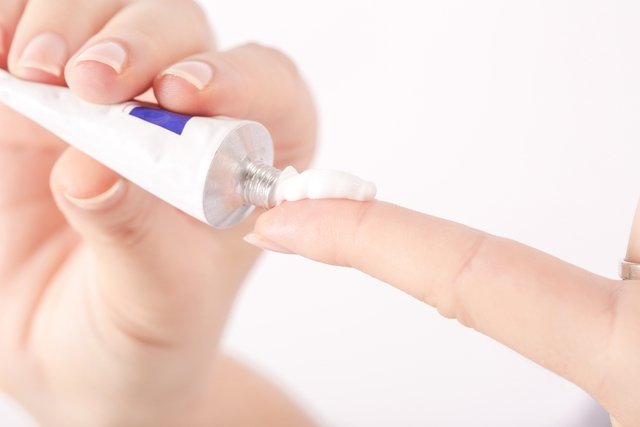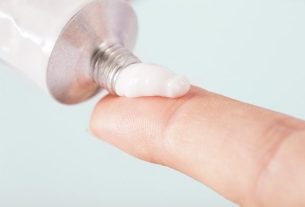Some antibiotic ointments, such as neomycin + bacitracin ointment, silver sulfadiazine, mupirocin or tobramycin, help eliminate bacteria that cause skin, gynecological or eye infections, and in some cases can also help with healing.
Typically, antibiotic ointments are indicated to treat infected wounds or to prevent infections, caused by surgery, burns, boils, acne, skin ulcers, conjunctivitis or infections in the cervix, for example.
Treatment with antibiotic ointments should always be carried out with advice from a dermatologist, general practitioner, gynecologist or ophthalmologist, who can recommend the best ointment according to the condition to be treated.
8 antibiotic ointments
Some antibiotic ointments are:
1. Neomycin + bacitracin
Neomycin + bacitracin ointment is an antibiotic that works by destroying and preventing the multiplication of bacteria that can cause skin infections, in addition to helping the skin heal.
This ointment can be found as generic “neomycin sulfate + zinc bacitracin” or under the trade names Nebacetin, Fericimed or Epicitrin, for example.
Neomycin + bacitracin ointment should not be used by babies, children, pregnant or breastfeeding women, or by people who have myasthenia gravis or kidney disease.
When indicated: treating infections such as open wounds, skin ulcers, boils, acne, infected pimples or eczema. Furthermore, it can also be used to prevent infections in skin burns or surgical scars, for example.
How to use: Apply a thin layer of neomycin ointment 5 mg/g and bacitracin 250 IU/g to the affected skin, with the help of gauze, 2 to 5 times a day, as instructed by the dermatologist. Learn how to use bacitracin and neomycin ointment correctly.
2. Silver sulfadiazine
Silver sulfadiazine is an antibiotic and healing ointment that works by preventing the multiplication of bacteria, in addition to having anti-inflammatory properties, promoting skin healing.
This ointment can be found as the generic “silver sulfadiazine” or under the trade names Dermazine or Silglós. Additionally, silver sulfadiazine can be found under the name Gino-Dermazine for gynecological use.
When indicated: prevention and treatment of surgical wounds, burns, skin ulcers or pressure ulcers. Furthermore, the ointment for gynecological use is indicated for infections in the vagina or cervix, cervicitis or to help healing after cauterization of the cervix or vaginal surgeries.
How to use: clean the skin and apply a layer of ointment to the skin lesion, 1 to 2 times a day, as instructed by the dermatologist, and bandage it with gauze. Find out how to use silver sulfadiazine.
In the case of silver sulfadiazine gynecological ointment, for infections or procedures on the cervix, the applicator provided in the packaging must be used once a day. For the healing of wounds on the vulva, you should not use the applicator, but just apply the ointment directly to the wound, 1 to 2 times a day, as advised by the gynecologist.
3. In pyrocina
Mupirocin is an antibiotic ointment that works by eliminating bacteria such as Staphylococcus aureus, Staphylococcus epidermidis e Streptococcus beta-hemolytics, responsible for causing skin infections.
Mupirocin ointment can be found as a generic or under the trade names Bactroban or Supirocin, for example, and should be used as recommended by your general practitioner or dermatologist.
When indicated: This ointment can be used for skin infections, such as impetigo, folliculitis or furunculosis, for example. See other ointments for boils.
How to use: To apply mupirocin 10 mg/g ointment, the affected area must be washed well with soap and water and a thin layer of the ointment must be applied to the affected skin region, with the help of sterile gauze. It is recommended to apply up to 3 times a day, for a maximum of 10 days, or according to the dermatologist’s instructions.
4. Nitrofural
Nitrofural antibiotic ointment has a bactericidal effect that helps eliminate bacteria that cause skin infection, such as Staphylococcus aureus, Streptococcus spp., Escherichia coli, Clostridium perfringens, Aerobacter aerogenes e Proteus spp.
This ointment can be found under the trade name Furacin and should only be used under the advice of a dermatologist.
When indicated: mupirocin ointment is indicated for the treatment of second and third degree burns, when there is infection or risk of infection, or after skin transplants, where bacterial contamination can cause transplant rejection. See other ointments for burns.
How to use: To apply the ointment with nitrofural 2 mg/g, you must wash the affected area well with soap and water and then apply a thin layer of the ointment to the affected skin with the help of sterile gauze. You should use it approximately 1 to 3 times a day, for 7 to 10 days, as recommended by your dermatologist.
5. Gentamicin
Gentamicin is an antibiotic ointment, generally found in association with other substances, such as betamethasone, tolnaftate and clioquinol, which in addition to eliminating bacteria, also eliminates fungi and reduces inflammation and itching in the skin.
This ointment is called Quadriderm and should be used under the guidance of a dermatologist according to the infection to be treated.
When indicated: a pomade of gentamicin, betamethasone, tolnaftate and clioquinol is indicated for dermatitis, balanopostitis, dyshidrosis, impetigo, pustular acne, seborrheic eczema, Tinea pedis, Tinea cruris, Tinea corporis or paronychia, for example.
How to use: the gentamicin and betamethasone, tolnaftate and clioquinol ointment should be applied in a thin layer, in an amount sufficient to cover the affected skin, 2 to 3 times a day, as instructed by the dermatologist.
6. Fusidic acid
Fusidic acid is an antibiotic ointment that works by preventing the multiplication of bacteria sensitive to this substance, especially Staphylococcus aureus.
This ointment has antibacterial action and is called Verutex, and should only be used under the advice of a dermatologist.
When indicated: fusidic acid ointment is indicated for bacterial skin infections caused mainly by the bacteria Staphylococcus aureus, such as impetigo, erythrasma or acne, for example. Check out other acne ointments.
How to use: clean the skin, washing with water and neutral soap or antiseptic and dry well. Apply fusidic acid ointment 20 mg/g 2 to 3 times a day, as directed by your doctor. Generally, treatment is carried out for 7 days.
7. Tobramicina
Tobramycin is an antibiotic in the form of an ophthalmic ointment that can be found containing only tobramycin or can be associated with other substances such as dexamethasone, which has a potent anti-inflammatory action.
Some examples of ophthalmic ointments containing tobramycin are Tobrex (tobramycin) or Tobracort (tobramycin + dexamethasone), for example, and should only be used under the advice of an ophthalmologist.
When indicated: Tobramycin ointment is indicated for eye infections, caused by infectious conjunctivitis, chemical, thermal or radiation burns to the eyes, for example.
How to use: tobramycin ointment 3 mg/g should be used by applying approximately one centimeter of the ointment to the conjunctival sac of the affected eye 2 to 3 times a day.
Tobramycin ointment 3 mg/g + dexamethasone 1 mg/g should be applied to the conjunctival sac, with a dose of approximately 1.5 cm of ointment, up to 3 or 4 times a day, as instructed by the ophthalmologist.
8. Cloranfenicol
Chloramphenicol ointment is an antibiotic with bacteriostatic action that works by preventing the multiplication of bacteria on the skin that are sensitive to this substance.
Chloramphenicol is usually found in association with collagenase, which helps remove dead tissue and crusts from the skin, and is found under the trade name Iruxol.
When indicated: Chloramphenicol ointment 10 mg/g + collagenase 0.6 U/g is indicated for cleaning skin lesions, such as decubitus ulcers, varicose ulcers, gangrene or postoperative lesions, for example.
How to use: Clean the skin lesion using gauze soaked in 0.9% saline to help remove crusts or necrotic tissue, and keep the skin moist. Then, apply the ointment directly to the lesion, or place the ointment in sterile gauze and apply to the lesion site, once a day, or as recommended by the dermatologist.
Care when using antibiotic ointment
Some precautions are important when using antibiotic ointment:
- Wash your hands before applying the ointment;
- Wash your hands after application, except in cases where the ointment is used for hand infections;
- Do not apply dermatological antibiotic ointment to the eyes. In these cases, there are specific ophthalmic ointments for eye infections;
- Do not cover the treated area with a bandage, unless recommended by your doctor.
Furthermore, antibiotic ointment should be used for the treatment period recommended by the doctor, even if symptoms improve quickly, in order to avoid bacterial resistance. Understand what bacterial resistance is and how to avoid it.
When not to use
Antibiotic ointments should not be used by children, pregnant or breastfeeding women, unless advised by a doctor.
Additionally, antibiotic ointments should not be used by people with a history of allergies to any of the ointment’s components.
Antibiotic ointments are contraindicated if there is no bacterial infection at the site.
In the case of preventing bacterial infections, antibiotic ointments should only be used if indicated by the doctor.

Sign up for our newsletter and stay up to date with exclusive news
that can transform your routine!
Warning: Undefined array key "title" in /home/storelat/public_html/wp-content/plugins/link-whisper-premium/templates/frontend/related-posts.php on line 12
Warning: Undefined array key "title_tag" in /home/storelat/public_html/wp-content/plugins/link-whisper-premium/templates/frontend/related-posts.php on line 13




